
November 6, 2008

Doug Killam, associate fisheries biologist in the state Department of Fish and Game’s Red Bluff office, holds up a massive Chinook salmon carcass found late last week on Battle Creek near Anderson. DFG scientists estimate the fish weighed 85 pounds dead, and even more when it was alive. Courtesy of the California Department of Fish and Game.
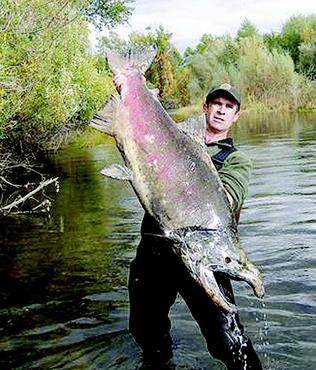
Dale Morrison of the Pacific States Marine Fisheries Commission holds a giant salmon carcass found last week on Battle Creek.
That is a rather large fish. Of course, you know what they say some Bigfoot eat, don’t you?
Wildlife officials in northern California last week came across one of the biggest Chinook salmon ever found in the state — a monster more than 4 feet long and weighing 85 pounds.
The Chinook salmon (Oncorhynchus tshawytscha) is a Pacific Ocean salmon, variously known as the king salmon, tyee salmon, Columbia River salmon, black salmon, chub salmon, hook bill salmon, winter salmon, Spring Salmon, Quinnat Salmon and blackmouth.
“We see lots of big ones,” Doug Killam, a biologist in the California Department of Fish and Game’s Red Bluff office, told the Redding Record Searchlight’s Dylan Darling, “but this one was just bigger than most big ones — it was just spectacular.”
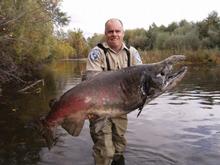
Measuring in at 51 inches – 4 1/4 feet – long, the male salmon was likely five to six years old, Killam said. Scientists used the salmon’s girth and length to come up with their estimate of 85 pounds – and that’s dead. The salmon probably weighed about 90 pounds alive when it started its swim from the Pacific Ocean back to Battle Creek, a tributary of the Sacramento River near the town of Anderson.
The California sport-fishing record for a Chinook salmon is 88 pounds. In Alaska, where they’re called king salmon, they get even bigger — the record sport catch is 97 pounds, while the largest commercial catch was a truly phenomenal 126 pounds.
“If someone would have caught this one, it probably would have been a state record,” Killam told the Record Searchlight.
Ironically, the sad state of salmon spawning in the Pacific Northwest probably helped this one live a full life. Ocean commercial catches were canceled this year, and the river sport season on the Sacramento drastically shortened.
The salmon found on Battle Creek is part of a meager salmon run on the stream that feeds the nicely named Coleman National Fish Hatchery.
But wait a second.
Forgive me for being careful about a photograph like the one floating around with this giant salmon story. Didn’t you ask yourself immediately whether it was photoshopped or an outright fake? Is this because we all are use to seeing hoaxed pictures like this?
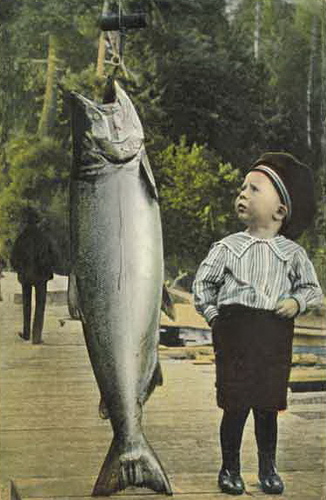
We all know the Wild West has a tradition of funny postcard-type images, don’t we?
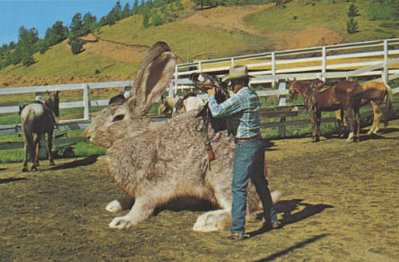
There is a new book with one of these old trophy fish covers, just out, entitled Giant Salmon: A Record of the Largest Atlantic Salmon Ever Caught (Firefly Books). It was released on September 12, 2008, and is authored by Fred Buller. At 480 pages long, the large tome concerns the true fish tales of record Atlantic salmon (not Pacific salmon, please note) fly catches around the world. I haven’t seen a copy yet, but I’m interested.
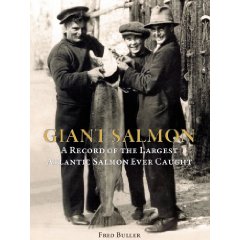
About Loren Coleman
Loren Coleman is one of the world’s leading cryptozoologists, some say “the” leading living cryptozoologist. Certainly, he is acknowledged as the current living American researcher and writer who has most popularized cryptozoology in the late 20th and early 21st centuries.
Starting his fieldwork and investigations in 1960, after traveling and trekking extensively in pursuit of cryptozoological mysteries, Coleman began writing to share his experiences in 1969. An honorary member of Ivan T. Sanderson’s Society for the Investigation of the Unexplained in the 1970s, Coleman has been bestowed with similar honorary memberships of the North Idaho College Cryptozoology Club in 1983, and in subsequent years, that of the British Columbia Scientific Cryptozoology Club, CryptoSafari International, and other international organizations. He was also a Life Member and Benefactor of the International Society of Cryptozoology (now-defunct).
Loren Coleman’s daily blog, as a member of the Cryptomundo Team, served as an ongoing avenue of communication for the ever-growing body of cryptozoo news from 2005 through 2013. He returned as an infrequent contributor beginning Halloween week of 2015.
Coleman is the founder in 2003, and current director of the International Cryptozoology Museum in Portland, Maine.
Filed under Breaking News, Cryptotourism, CryptoZoo News, Megafauna, Photos, Weird Animal News